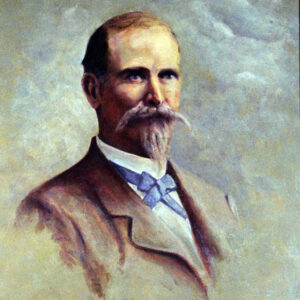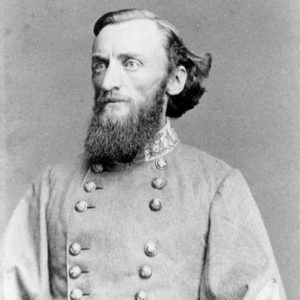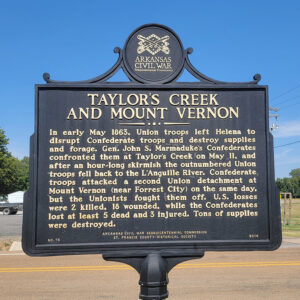calsfoundation@cals.org
Skirmishes at Taylor's Creek and Mount Vernon
aka: Skirmish at Crowley's Ridge
| Location: | St. Francis County |
| Date: | May 11, 1863 |
| Campaign: | Scouting expedition into St. Francis County to destroy Confederate supplies and stop Confederates from reestablishing in eastern Arkansas |
| Principal Commanders: | Colonel Powell Clayton, Lieutenant Colonel Wilton A. Jenkins (US); Brigadier General John S. Marmaduke, Colonel George W. Carter, Colonel Colton Greene (CS) |
| Forces Engaged: | First Indiana Cavalry, Fifth Kansas Cavalry (Jenkins), and Fifth Illinois Cavalry (James Farnan) (US); Nathan Burford’s Nineteenth and D. C. Giddings’s Twenty-first Texas Cavalry, Joseph Pratt’s Tenth Texas Artillery, Charles Morgan’s cavalry squadron, M. L. Young’s Tenth Missouri Cavalry (CS) |
| Estimated Casualties: | 2 killed, 18 wounded (US); unknown, but at least 5 killed and 3 wounded (CS) |
| Result: | Stalemate |
Returning from his ill-fated attack on Cape Girardeau, Missouri, in April 1863, John S. Marmaduke scattered his Confederate forces from Wittsburg (Cross County) to Marianna (Lee County) in Arkansas, with Archibald Dobbins at Hughes’ Ferry. Hearing of Marmaduke’s return, Federal commanders at Helena (Phillips County) ordered Colonel Powell Clayton to take approximately 1,000 cavalry and three pieces of artillery to stop the Confederates from reestablishing in eastern Arkansas by destroying all food supplies and forage. If Confederates were denied this support system of food, shelter, and slaves, the Federal army could maintain superiority in eastern Arkansas and the Mississippi River to Helena, thus enhancing Ulysses S. Grant’s campaign to take Vicksburg, Mississippi. Clayton’s second goal was to determine if Sterling Price’s infantry at Little Rock (Pulaski County) and Marmaduke’s cavalry had planned a combined assault on Helena.
Leaving Helena on May 6, the Federal troops moved along the Lower Little Rock Road to Cotton Plant (Woodruff County), where they picked up the old Military Road. Along the way, Clayton’s troops participated in some of the most demoralizing destruction known in Phillips County during the Civil War, as the cavalrymen burned and destroyed homes, farms, and plantations, killing all domesticated animals and freeing all encountered slaves. By May 10, Clayton reached the only causeway over the L’Anguille River: Seaburn’s bridge, just east of Taylor’s Creek.
Marmaduke learned of Clayton’s forces on May 9 and began moving troops into position the next day—Colonel Colton Green and Colonel George W. Carter to Taylor’s Creek and Dobbins to Seaburn’s bridge. The general hoped to catch Clayton in a pinching movement, where he could easily capture or destroy the Federals. He believed Clayton’s forces comprised cavalry, infantry, and artillery, amounting to almost 2,000 men. Despite his orders, Dobbins lingered at Hughes’ Ferry and did not participate in any fighting, but his inaction played a key role in the military encounters.
By early evening of May 10, Clayton divided his forces. He retained 230 men from the First Indiana and their three small steel guns, and Company B of the Fifth Illinois to guard the bridge—the Federal forces’ only secure western escape route. Lieutenant Colonel Wilton A. Jenkins, with the Fifth Kansas and Fifth Illinois, moved toward Taylor’s Creek with orders to locate Dobbins, destroy supplies, and determine if Hughes’ Ferry remained a viable southern crossing point for the Federal forces.
Jenkins’s horsemen left Taylor’s Creek prior to sunrise on May 11, moving down the old Madison Road, and missing the Confederate cavalry advance. Learning of Marmaduke’s forces, Clayton’s men at the bridge advanced, skirmishing with Carter’s pickets at the Taylor’s Creek crossroads. Initially pushing Carter back, Clayton realized he was about to be overwhelmed when he met Confederate forces in the line of battle. A brisk engagement followed, with Clayton quickly returning to Seaburn’s bridge, pursued by Young’s Tenth Missouri Cavalry and two cannon. Marmaduke still believed he faced a superior Federal force and held Greene’s men in check just east of the bridge, waiting for Dobbins to attack Clayton from the west. Dobbins finally arrived around 3:30, but instead of attacking, he left his men for a consultation with Marmaduke. Though Dobbins supposedly guarded all avenues westward, Clayton withdrew his forces after sunset, silently escaping from Marmaduke’s encasement. Dobbins did not pursue.
By early afternoon, rumors reached Marmaduke that Jenkins’s Federal troops were on the Madison Road, burning and pillaging as they moved south. Marmaduke sent Carter’s Texans and Pratt’s four guns to Mount Vernon to protect his southern flank. Learning of Marmaduke’s attack on Clayton, Jenkins made a retrograde movement northward with the Fifth Kansas, while the Fifth Illinois stopped at a plantation to eat. Just south of Mount Vernon, the Kansans met the advance guard from Burford’s Nineteenth Texas and Morgan’s cavalry, with the Twenty-first Texas held in line of battle across the Madison Road. Jenkins deployed his 325 Kansans behind fallen timber and sent for the Fifth Illinois. The Twenty-first charged twice, but Jenkins easily repulsed both actions. Just before Carter’s third charge, the Fifth Illinois rode into action, prompting Carter to withdraw his forces. The fighting at Mount Vernon lasted less than an hour.
With the Fifth Illinois covering his retreat, Jenkins moved his troops to Hughes’ Ferry, reaching the crossing between ten o’clock and midnight. Carter did not pursue. Stalemated by a lesser Federal force, Marmaduke also lost his chance to reestablish his forces in eastern Arkansas by his inability to stop Clayton’s destruction of the Confederate support system in Phillips and Woodruff counties and what later became Lee County. Clayton’s Federals maintained their military hold in eastern Arkansas, avoiding disaster through the incompetence of Confederate leaders. Even Marmaduke criticized his commanders, especially Dobbins, and wanted to punish “the incompetent party.” The Confederates would not recover until late June, when the combined Confederate armies moved toward Helena for their July 4 attack.
For additional information:
Fry, Alice L. Following the Fifth Kansas Cavalry: The Letters. Independence, MO: Two Trails Publishing, Co., 1998.
Hewett, Janet B., et al. Supplement to the Official Records of the Union and Confederate Armies. Pt. 1, vol. 4, pp. 123–130. Wilmington, NC: Broadfoot Publishing Co., 1994–2008.
Kohl, Rhonda. “Raising Thunder with the Secesh: Powell Clayton’s Federal Cavalry at Taylor’s Creek and Mount Vernon, Arkansas, May 11, 1863.” Arkansas Historical Quarterly 64 (Summer 2005): 146–170.
Walton, Major Buck. An Epitome of My Life: Civil War Reminiscences. Austin, TX: The Waterloo Press, 1965.
The War of the Rebellion: A Compilation of the Official Records of the Union and Confederate Armies. Ser. 1, vol. 22, pt. 1, pp. 323–328; vol. 22, pt. 2, pp. 836–37, 845. Washington, DC: Government Printing Office, 1880–1901.
Zuber, William P. My Eighty Years in Texas. Austin: University of Texas Press, 1971.
Rhonda M. Kohl
Jeffersonville, Indiana
 Civil War Timeline
Civil War Timeline ACWSC Logo
ACWSC Logo  Powell Clayton
Powell Clayton  John Marmaduke
John Marmaduke  Taylor's Creek and Mount Vernon Skirmishes
Taylor's Creek and Mount Vernon Skirmishes 




Comments
No comments on this entry yet.